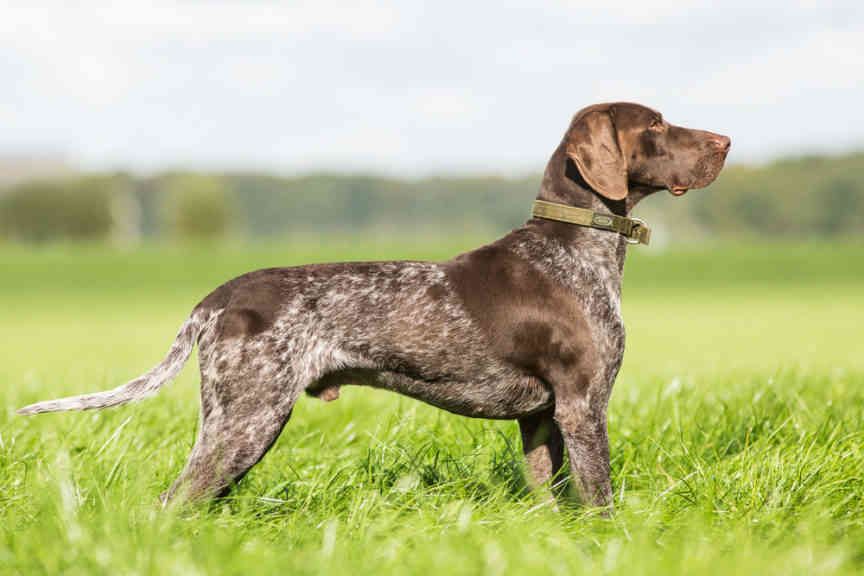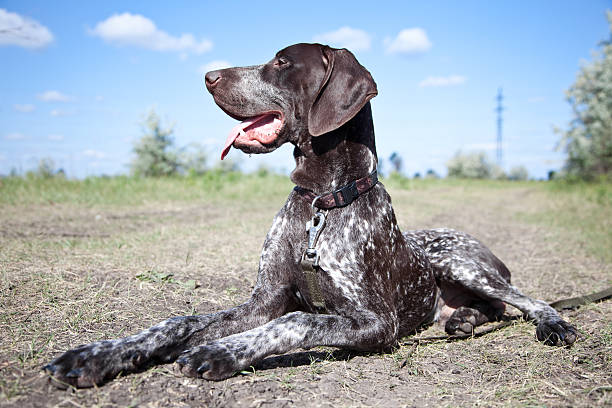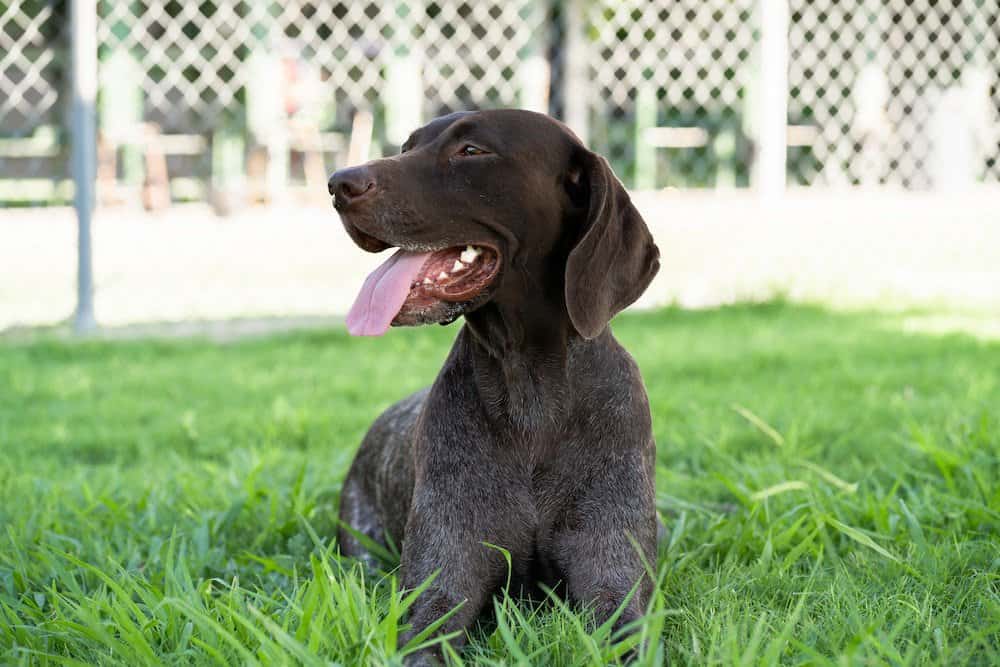Are you ready to embark on an exciting journey of training your German Shorthaired Pointer (GSP) to become a skilled hunting companion? Look no further! In this guide, I will share with you the essential steps to train your GSP to hunt like a pro.
First and foremost, crate training, basic obedience, and exposure to birds are the building blocks of training a GSP for hunting. Starting with puppy kindergarten, where your GSP will learn basic commands like sit, stay, and come, lays a solid foundation for their training. Additionally, introducing your puppy to live birds at the breeder's place will help them develop their natural hunting skills.
But it doesn't end there! Gradually exposing your GSP to the sound of a gun and gunfire during training is crucial to desensitize them. Once your puppy is ready, they can start hunting and learn to point and retrieve birds. Consistency, positive reinforcement, and short training sessions are key ingredients for success in training your GSP.
Remember, GSPs have a natural hunting instinct that needs to be managed even if they are not being used for hunting. Regular exercise is vital to release their energy and prevent destructive behavior. Leash training, socialization, and teaching them to bark on command are also important aspects of their training.
So, if you're ready to unleash the hunting potential of your GSP, let's dive into the training process together. With patience, dedication, and the right techniques, you'll have a skilled hunting partner by your side in no time.
Key Takeaways
- The training process for a German Shorthaired Pointer (GSP) involves crate training, basic obedience, and exposure to birds.
- Puppy kindergarten is recommended for GSPs to learn basic commands and socialize with other dogs.
- Consistency, positive reinforcement, and short training sessions are key in training GSPs.
- Regular exercise and mental stimulation are important for GSPs to prevent destructive behavior.
- Obedience training strengthens the bond between GSPs and their owners and helps them overcome bad habits.

1. Crate Training and House Training
1.1 Introduction to Crate Training
Crate training is an essential aspect of training a German Shorthaired Pointer (GSP) puppy. It provides them with a safe and comfortable space that they can consider their own. The crate serves as a den-like environment where the puppy can relax, sleep, and feel secure.
To start crate training, choose a crate that is appropriately sized for your GSP puppy. The crate should be large enough for them to stand up, turn around, and lie down comfortably. It's important to make the crate a positive and inviting space for the puppy. Place a soft blanket or bedding inside, along with a few toys or chew treats to keep them entertained.
Introduce your GSP puppy to the crate gradually. Encourage them to enter the crate by placing treats or their favorite toys inside. Use positive reinforcement by praising and rewarding them when they voluntarily go into the crate. Initially, keep the crate door open and allow the puppy to explore it at their own pace.
As your GSP puppy becomes more comfortable with the crate, gradually start closing the door for short periods of time. Stay nearby and provide reassurance if they become anxious or start whining. Gradually increase the duration of crate time, making sure to let them out for regular potty breaks and exercise.
Crate training helps with house training as well. Dogs naturally avoid soiling their sleeping area, so the crate becomes a useful tool in teaching them to hold their bladder and bowels. Be consistent with a regular potty schedule, taking your GSP puppy outside after meals, playtime, and naps. Reward them with praise and treats when they eliminate in the appropriate spot.
Remember, crate training should never be used as a form of punishment. It should always be a positive experience for your GSP puppy, providing them with a sense of security and comfort.
1.2 House Training Tips
House training is an important aspect of raising a well-behaved GSP puppy. Here are some tips to help you effectively house train your furry friend:
- Establish a routine: Set a consistent schedule for feeding, potty breaks, and exercise. This helps your GSP puppy develop a regular bathroom routine and reduces the chances of accidents indoors.
- Supervise and confine: When your GSP puppy is not in their crate, keep a close eye on them. Use baby gates or a playpen to confine them to a designated area where accidents can be easily cleaned up.
- Take them outside frequently: Puppies have small bladders and may need to eliminate as often as every 30 minutes to an hour. Take your GSP puppy outside frequently, especially after meals, naps, playtime, and waking up in the morning.
- Use consistent cues: Choose a specific word or phrase, such as "go potty," to associate with elimination. Use this cue every time you take your GSP puppy outside to reinforce the desired behavior.
- Reward and praise: When your GSP puppy eliminates in the appropriate spot, reward them with praise, treats, or a combination of both. Positive reinforcement helps them understand that going potty outside is the desired behavior.
- Clean accidents properly: If your GSP puppy has an accident indoors, clean it up thoroughly using an enzymatic cleaner to remove any lingering scent. This helps prevent them from associating that area with a bathroom spot.
- Be patient and consistent: House training takes time and patience. Stay consistent with the routine, cues, and rewards to reinforce good habits. Avoid punishing your GSP puppy for accidents, as this can create fear and anxiety.
By following these crate training and house training tips, you can set your German Shorthaired Pointer puppy up for success in their hunting journey. Remember to be consistent, patient, and provide plenty of positive reinforcement along the way.

2. Basic Obedience and Socialization
Training a German Shorthaired Pointer (GSP) to hunt requires a combination of crate training, basic obedience, and exposure to birds. In this section, we will explore two important aspects of training: Puppy Kindergarten and Teaching Basic Commands.
2.1 Puppy Kindergarten
Puppy Kindergarten is highly recommended for GSPs to learn basic commands and socialize with other dogs. This early training establishes a foundation for their development and helps them become well-rounded hunting companions. During Puppy Kindergarten, GSP puppies are taught commands such as sit, stay, and come. These commands are essential for their safety and control in hunting situations.
2.2 Teaching Basic Commands
Along with Puppy Kindergarten, teaching basic commands plays a crucial role in training a GSP to hunt effectively. One important aspect is introducing the puppy to live birds, which can be done at the breeder's place. This exposure helps the puppy develop their natural hunting skills and instincts. Gradually, the puppy should also be introduced to the sound of a gun and gunfire during training, ensuring they become accustomed to these noises in the hunting field.
Once the puppy has mastered basic commands and shown a readiness to hunt, they can begin their journey as a hunting companion. Training them to point and retrieve birds is an essential part of their development. Consistency, positive reinforcement, and short training sessions are key in training GSPs. Their natural intelligence and responsiveness to reward-based training make them quick learners.
It's important to note that GSPs have a strong hunting instinct that needs to be managed if they are not being used for hunting purposes. Regular exercise is crucial for GSPs to release their energy and prevent destructive behavior. Additionally, training them to bark on command and be quiet can help control their tendency to bark excessively.
Crate training and house training are also important aspects of training GSP puppies. These techniques help establish boundaries and teach them appropriate behavior in the home environment. Leash training and socialization are equally important to ensure that GSPs are well-behaved and comfortable in various settings.
In conclusion, training a German Shorthaired Pointer to hunt requires a combination of basic obedience, socialization, and exposure to hunting scenarios. Starting early with Puppy Kindergarten and gradually introducing the puppy to live birds and gun noises are essential steps in their development. Consistency, positive reinforcement, and short training sessions are key to their success. By establishing a strong foundation in basic commands and providing regular exercise, GSPs can become skilled hunting companions and beloved family pets.
For more detailed information on training German Shorthaired Pointers, you can refer to the source.
3. Developing Hunting Skills
3.1 Introduction to Birds
As a proud owner of a German Shorthaired Pointer (GSP), you're probably eager to develop their hunting skills. Well, you've come to the right place! Training a GSP to hunt involves a combination of crate training, basic obedience, and exposure to birds. One of the first steps in this process is to introduce your puppy to the world of birds.
To kickstart their hunting instincts, it's recommended to enroll your GSP puppy in a puppy kindergarten. Here, they can learn basic commands like sit, stay, and come. These commands serve as building blocks for their hunting training. However, the real excitement begins when you expose your puppy to live birds at the breeder's place.
By letting your GSP puppy interact with live birds, they can start developing their hunting skills naturally. This exposure helps them understand the scent, sight, and behavior of birds, which are essential for successful hunting. Keep in mind that while GSPs have a natural hunting instinct, it still needs to be nurtured and managed through proper training.
3.2 Gradual Exposure to Guns
Now that your GSP puppy has gained some experience with birds, it's time to introduce them to the world of guns. Gunfire is a common element in hunting, and it's crucial for your GSP to be comfortable with the sound and presence of guns. However, it's important to approach this step gradually and with caution.
Start by exposing your puppy to the sound of a gun in a controlled environment. You can begin by playing recordings of gunfire at a low volume while engaging in positive activities with your puppy, such as playing or training. This helps them associate the sound with positive experiences, minimizing any potential fear or anxiety.
As your GSP grows more comfortable, gradually increase the volume of the gunfire recordings. Monitor their reactions closely and ensure they remain calm and relaxed throughout the process. Eventually, you can transition to actual gunfire in a safe and controlled outdoor setting.
Remember, consistency, positive reinforcement, and short training sessions are key in training GSPs. By gradually exposing your puppy to guns, you're helping them develop the necessary confidence and familiarity to become skilled hunting companions.

References
4. Pointing and Retrieving Birds
Training a German Shorthaired Pointer (GSP) to hunt requires a structured approach that involves crate training, basic obedience, and exposure to birds. These intelligent and energetic dogs have a natural hunting instinct that can be honed with the right training techniques. In this section, we will explore two important aspects of training a GSP to hunt: starting the hunting process and teaching pointing and retrieving.
4.1 Starting the Hunting Process
To begin the hunting journey with your GSP, it is essential to lay a strong foundation through early socialization and basic obedience training. Puppy kindergarten is highly recommended for GSPs, as it provides a structured environment for them to learn essential commands such as sit, stay, and come. This early training helps establish a bond between you and your GSP and sets the stage for more advanced hunting training.
Another crucial step in the hunting process is introducing your GSP puppy to live birds. This can be done at the breeder's place or with the help of a professional trainer. By exposing the puppy to birds, they begin to develop their natural hunting skills and instincts. This early exposure helps them understand the concept of scenting, pointing, and retrieving.
Gradual exposure to the sound of a gun and gunfire is also vital in training a GSP for hunting. Start by playing audio recordings of gunshots at a low volume and gradually increase the volume over time. This helps the puppy become familiar with the sound and prevents them from being startled when they encounter gunfire during actual hunting trips.
4.2 Teaching Pointing and Retrieving
Once your GSP puppy has developed a strong foundation in basic obedience and has been exposed to live birds and gun sounds, you can start teaching them the specific skills of pointing and retrieving.
Pointing is a natural behavior for GSPs, but it still requires training to refine and control this instinct. Begin by using a wing or feather to simulate a bird's scent. Encourage your GSP to find the scent and "point" by freezing in a standing position. Reward them with treats and praise when they exhibit this behavior. Gradually introduce the cue word "point" as they associate it with the action.
Retrieving is another important skill for a hunting GSP. Start by introducing a dummy or a soft retrieving toy. Toss it a short distance and encourage your GSP to retrieve it. Use positive reinforcement, such as treats and praise, to reward them for bringing back the item. Gradually increase the distance and complexity of the retrieves as your GSP becomes more proficient.
Consistency, positive reinforcement, and short training sessions are key to successfully train a GSP to point and retrieve birds. As with any training, it is important to remember that every dog is unique and may progress at a different pace. Patience and understanding are essential throughout the training process.
By following these training techniques and methods, you can help your GSP develop into a skilled hunting companion. Remember to always prioritize the well-being and safety of your dog during training sessions.
For more information on training German Shorthaired Pointers, check out this source.
5. Managing Natural Hunting Instinct
German Shorthaired Pointers (GSPs) are known for their exceptional hunting abilities. They have a natural hunting instinct that drives them to track and retrieve game. While these skills make them excellent hunting partners, it's important to manage their hunting instinct when they are not being used for hunting purposes. In this section, we will explore two key aspects of managing a GSP's natural hunting instinct: controlling behavior in non-hunting situations and regular exercise to release energy.
5.1 Controlling Behavior in Non-Hunting Situations
GSPs possess a strong prey drive, which means they may exhibit certain behaviors such as chasing small animals or birds, digging, or even trying to escape. To prevent these behaviors from becoming problematic, it's essential to establish boundaries and provide consistent training.
One effective method is to teach your GSP the "leave it" command. This command helps redirect their attention away from potential prey and onto you. Start by using treats or toys to practice the command in controlled environments. Gradually increase the difficulty by introducing distractions, such as tempting scents or moving objects. Remember to reward your GSP with praise and treats when they successfully respond to the command.
Another important aspect of managing a GSP's behavior is teaching them to bark on command and be quiet. GSPs tend to be vocal and may bark excessively if not trained properly. By teaching them to bark on command, you can control their barking behavior and prevent it from becoming a nuisance. Similarly, training them to be quiet on command will help maintain peace and harmony in your home.
5.2 Regular Exercise to Release Energy
GSPs are high-energy dogs that require regular exercise to stay happy and healthy. Without adequate physical and mental stimulation, they may become bored or anxious, leading to destructive behaviors such as chewing or excessive barking. To prevent these issues, it's important to provide your GSP with plenty of exercise opportunities.
Engaging in activities that mimic their natural hunting instincts can be particularly beneficial. Taking your GSP for long walks, jogs, or hikes in the great outdoors allows them to explore and burn off excess energy. Additionally, interactive games like fetch, hide-and-seek, or puzzle toys can mentally stimulate your GSP and keep them entertained.
It's important to note that exercise should be tailored to your GSP's age and physical condition. Consult with your veterinarian to determine the appropriate amount and intensity of exercise for your furry friend.
By managing their natural hunting instinct through behavior control and regular exercise, you can ensure that your GSP remains a well-behaved and content companion, even when they are not actively hunting.

Source: Field & Stream - A Gun Dog's First Year of Hunting
6. Overcoming Bad Habits
German Shorthaired Pointers (GSPs) are energetic and intelligent dogs with a natural hunting instinct. While this instinct can make them excellent hunting companions, it can also lead to some challenging behavior if not properly managed. In this section, we will explore two common bad habits in GSPs and discuss strategies for overcoming them.
6.1 Excessive Barking and Chasing Instincts
GSPs are known to be vocal dogs, and they can bark excessively if not trained to control their barking. Whether it's barking at strangers, other animals, or simply out of boredom, excessive barking can be a nuisance for both the dog and their owners.
To address this behavior, it's important to establish clear communication with your GSP. Teach them the "speak" and "quiet" commands, rewarding them when they bark on command and then stop barking when asked. Consistency is key in this training process, so make sure to reinforce the desired behavior every time.
In addition to excessive barking, GSPs also have a strong chasing instinct, which can lead them to relentlessly pursue small animals or even cars. This behavior can be dangerous and should be addressed early on.
One effective approach is to redirect their chasing instinct towards appropriate activities. Engage your GSP in games that involve retrieving toys or playing fetch. This not only satisfies their instinctual drive but also provides mental and physical stimulation. Remember to reward them for focusing their attention on these activities instead of chasing.
6.2 Separation Anxiety
GSPs are known to be highly sociable dogs who form strong bonds with their owners. However, this strong attachment can sometimes lead to separation anxiety when they are left alone.
Separation anxiety in GSPs can manifest in destructive behavior, excessive barking, and even attempts to escape. To help your GSP overcome separation anxiety, it's important to gradually introduce them to being alone for short periods of time and gradually increase the duration.
Crate training can be a valuable tool in managing separation anxiety. Create a positive association with the crate by providing treats and toys inside, and gradually extend the time your GSP spends in the crate while you are away. Additionally, leave them with interactive toys or puzzles to keep them mentally stimulated during your absence.
Socializing your GSP with other dogs and people from an early age can also help reduce separation anxiety. This exposure to different environments and experiences helps build their confidence and teaches them that being alone is not a cause for concern.
Remember, overcoming bad habits in GSPs takes time and consistent training. By providing them with clear boundaries, positive reinforcement, and plenty of mental and physical exercise, you can help your GSP become a well-behaved and happy companion.
For more information on training German Shorthaired Pointers, refer to Paw Tracks.
7. Strengthening the Bond with Obedience Training
Obedience training is a crucial aspect of nurturing a strong bond between you and your German Shorthaired Pointer (GSP). Not only does it help in establishing a foundation of discipline and control, but it also ensures the safety of your furry companion. In this section, we will explore the importance of obedience training for GSPs and discuss the effectiveness of using positive reinforcement techniques.
7.1 Importance of Obedience Training
For GSPs, obedience training is more than just a means to control their behavior; it is an opportunity to strengthen the bond and trust between you and your canine friend. By teaching your GSP basic commands like sit, stay, come, and heel, you establish yourself as the leader and provider of guidance. This not only instills obedience but also helps in preventing potential behavior problems.
When properly trained, GSPs become well-mannered, obedient, and reliable companions. They learn to respect boundaries, follow commands, and exhibit self-control. This is particularly important for GSPs as they have a natural hunting instinct that needs to be managed, especially if they are not being utilized for hunting purposes. Obedience training helps channel their energy and instincts in a constructive manner, preventing destructive behavior and promoting a harmonious living environment.

7.2 Using Positive Reinforcement
Positive reinforcement is a highly effective training technique when it comes to GSPs. These intelligent dogs respond well to rewards and praise, making it essential to incorporate positive reinforcement into their training regimen. By utilizing treats, toys, and verbal praise, you can motivate and encourage your GSP to learn and perform desired behaviors.
During training sessions, it is important to keep the atmosphere positive and enjoyable. GSPs thrive on consistency and short, focused training sessions. By breaking down commands into smaller steps and gradually increasing the difficulty, you can ensure successful learning and prevent frustration for both you and your furry companion.
Remember, the goal of positive reinforcement is to reward desired behaviors rather than punishing unwanted ones. This approach not only helps in building a strong bond but also instills trust and confidence in your GSP. Using positive reinforcement, you can reinforce good habits, overcome bad behaviors, and shape your GSP into a well-rounded and obedient companion.
Field and Stream is an excellent resource for further information on training your German Shorthaired Pointer to hunt and establish a strong bond through obedience training.
In the next section, we will delve into the crucial aspects of crate training and house training for GSP puppies, providing you with valuable insights and techniques to effectively train your furry friend.

Frequently Asked Questions
How should I train a German Shorthaired Pointer (GSP) for hunting?
The training process for a GSP to hunt involves crate training, basic obedience, and exposure to birds. Gradually introducing the puppy to live birds at the breeder's place helps them develop hunting skills. The puppy should also be gradually introduced to the sound of a gun and gunfire during training. Once the puppy is ready, they can start hunting and learn to point and retrieve birds.
Is puppy kindergarten recommended for GSPs?
Yes, puppy kindergarten is recommended for GSPs. It helps them learn basic commands like sit, stay, and come. It also provides an opportunity for socialization with other puppies.
How can I manage a GSP's natural hunting instinct if they are not being used for hunting?
GSPs have a natural hunting instinct that needs to be managed if they are not being used for hunting. Regular exercise is important for them to release energy and prevent destructive behavior. Training them to bark on command and be quiet can also help manage their hunting instincts.
What are important aspects of training GSP puppies?
Important aspects of training GSP puppies include crate training, house training, leash training, and socialization. Crate training helps with housebreaking and providing a safe space for the puppy. House training teaches them where to eliminate. Leash training and socialization help them become well-behaved and comfortable in different environments.
How should I start training my GSP?
Training should start as early as possible with socialization and exposure to different environments. Teaching basic commands like come, sit, down, stay, heel, and no is important. Training sessions should be kept short and positive reinforcement should be used.
Can obedience training help with bad habits in GSPs?
Yes, obedience training can help GSPs overcome bad habits like excessive barking, chasing instincts, and separation anxiety. Good obedience training and regular exercise can provide mental stimulation and keep them well-behaved and content.




